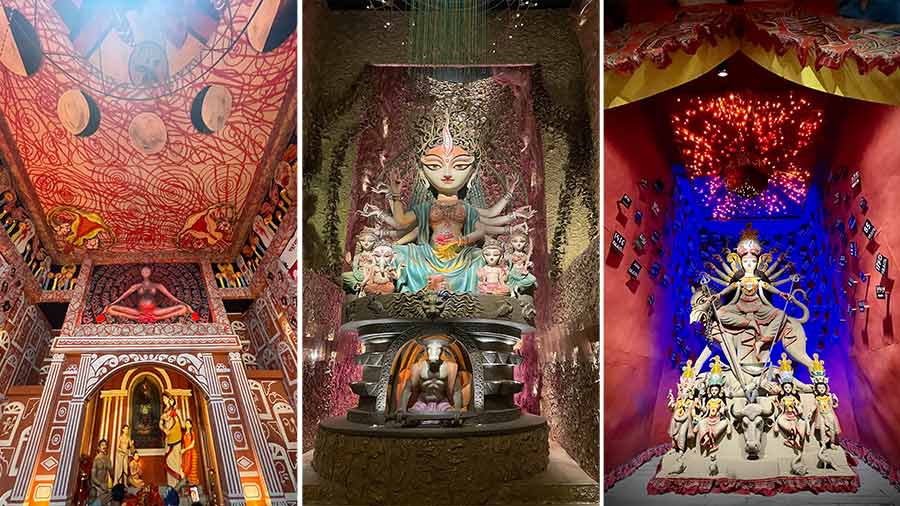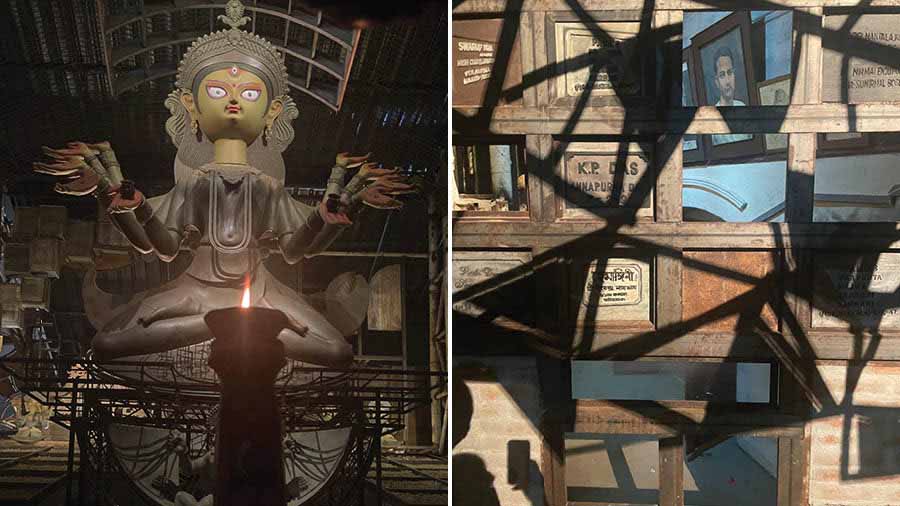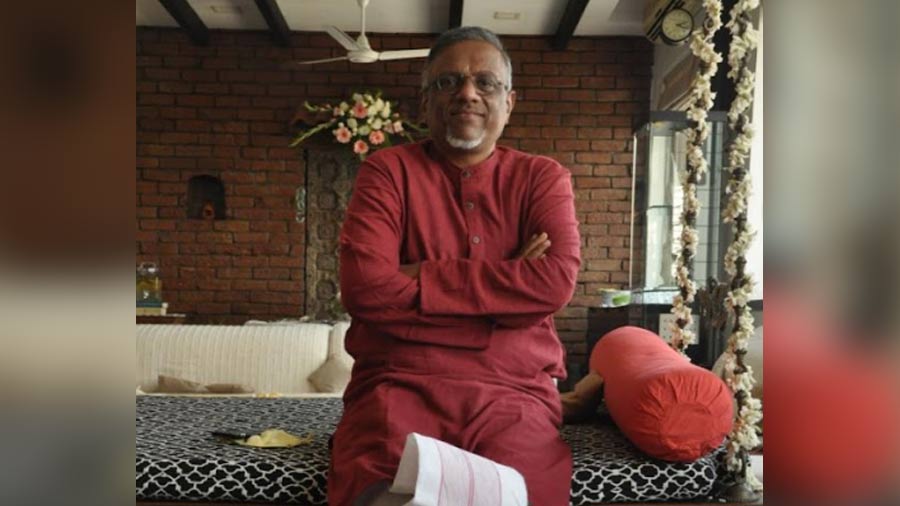How does one appraise a Pujo? I tried putting together a loose sheet that extends beyond ‘It must be a good Pujo because it looks good.’ One day, Pujos will be appraised not only on the basis of what appears good but also on the basis of how different, how courageous, how subtle and how informed they are.
The art of social messaging

Kashi Bose Lane Puja that focused on child trafficking as a theme
There will come a time when Pujos will be judged on the basis of ‘We know this is looking big but what is it trying to say?’ and ‘We know what you are trying to say but is it coming through clearly?’ and ‘Is the communication clarity touching every visitor?’ The one Pujo that ticked all three boxes was the one at Kashi Bose Lane (you never hear of this lane at any other time of the year and then suddenly…).

A garland of flowers on two beds with a couple of flowers plucked aside was possibly a reference to the word ‘deflowered’; (right) boxed apples in the place of ovaries of the girls on display
The child trafficking theme was in my face, the communication brutal and the impact enduring. The theme was represented across three enclosures so even if you recovered from what you saw in the first, there was a second in wait; if you rebounded from the second, there was a third. This is what I ‘took home’: a collection of dismembered tongues aggregated in the middle of a revolving disc in the first hall, waiting vultures on the periphery and boxed apples in the place of ovaries of the girls on display. In the next hall, a garland of flowers on two beds with a couple of flowers plucked aside was possibly a reference to the word ‘deflowered’. In this hall, there was a life-size statue of a girl (possibly 12 years old) looking into a three-part mirror. So if you stood behind her you could see her frontal image on the two side mirrors looking directly at you. In the third hall, there was a girl seeking to flee her circumstances — hung from 30 feet high. I couldn’t find on site the name of the curator but possibly he or she is a poet-cum-artist-cum-hangman.
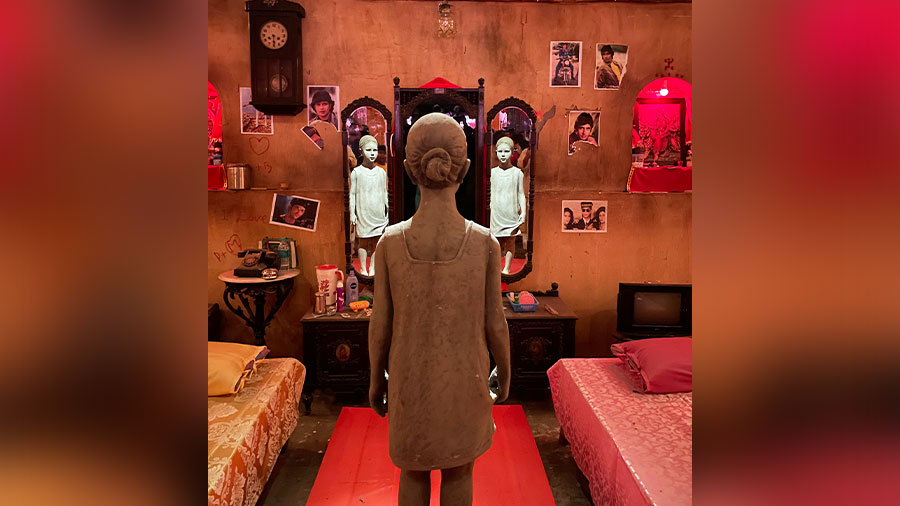
A life-size statue of a girl looking into a three-part mirror as part of the installation
I would have liked the curator to be present to engage with visitors (or even a note telling visitors like me the time he or she would have been in attendance, so that I could have coordinated my visit). I would have liked to kiss the back of the hand of this storyteller; I would have liked to have seen the names of all NGOs working in the child trafficking space so that visitors could have transformed this Pujo from a milestone into a journey. Maybe next time.
The art of curating a time-neutral Pujo
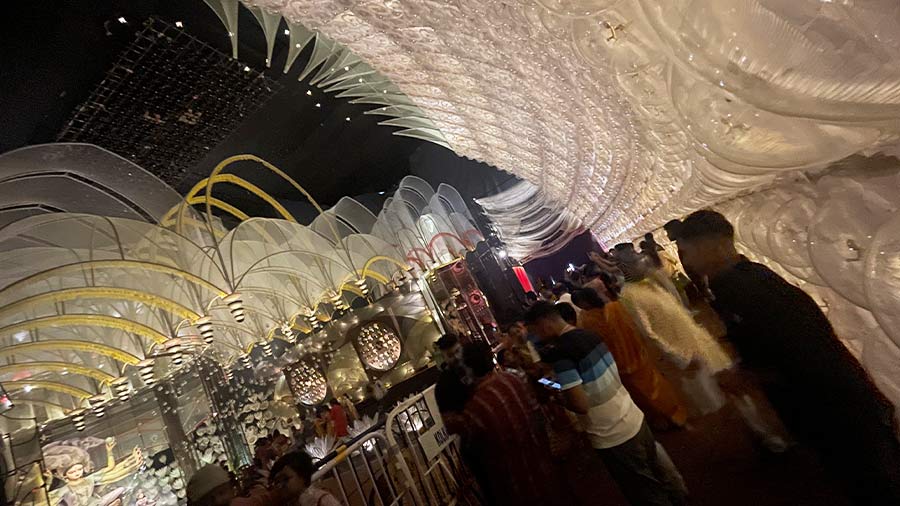
Art installations at Chorebagan
The Pujos of the future will be appraised by whether they were curated for time-neutrality. There were Pujos like Shib Mandir, Naktala Udayan Sangha and Tala Prattoy essentially designed for post-dusk appreciation. I visited Naktala early morning and then late evening and the impact outcomes — the Pujo addressed the subject of Partition migration — were chalk and cheddar. The evening outcome was haunting; but at 9am on Nabami, there was no background commentary or song, no four-page researched leaflet and no guide. There will come a time when Pujos will be appraised on how easy they make it for daytime travellers (who help decongest the city by using non-peak hours). I would have scored Chorebagan Sarbajonin high, the entire Pujo curated inside a black box (including black air curtains), so it made no difference if one visited at midnight or mid-day.
The courage to conceptualise on the frontier
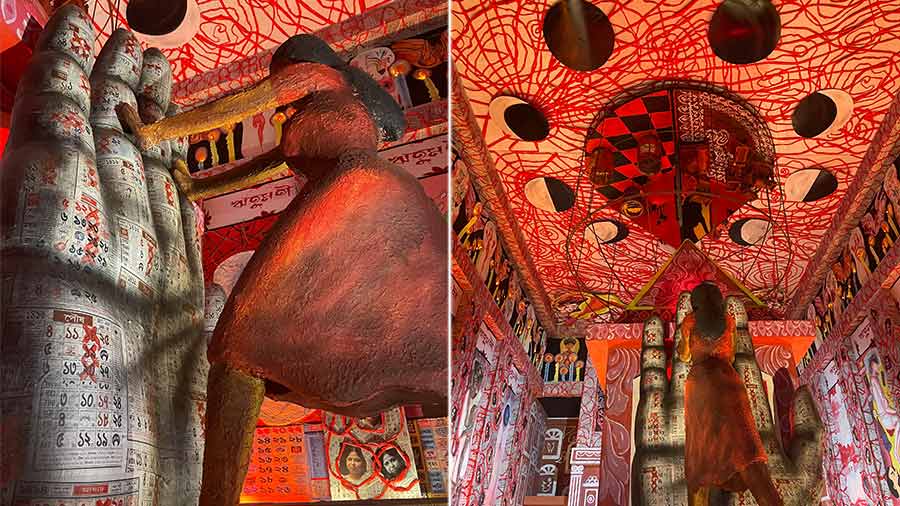
Pathuriaghat Pancher Palli selected the menstruation cycle as a theme for this year’s Pujo
There is always the temptation to launch a ‘safe’ Pujo — picking subjects that no one is likely to tick the organiser off for (like a fund manager putting out a buy call on Infosys). I like to see which Pujo committee is putting its neck on the line. If I had to give an award for this priority, it would go to Pathuriaghat Pancher Palli for having selected the menstruation cycle as a theme for this year’s Pujo. The central attraction is not the protima but a firmly upraised palm refusing temple entry to a girl during her menstruation cycle — in plaster of Paris. This is not as irrelevant as you think; in another part of the country women are not permitted entry into temples, period (no pun). Some who came to the Pujo may have cringed: ‘Onek theme chhilo. Eita select korlen keno aapnara?’ Which is precisely why this subject needs to be brought into drawing room conversations. The subject could have been taken a step further if an on-site touchscreen could have articulated the subject deeper. Sometimes it is best not to leave themes to the reinterpretation of an audience seeking to finish a Pujo in three minutes and move to the next.
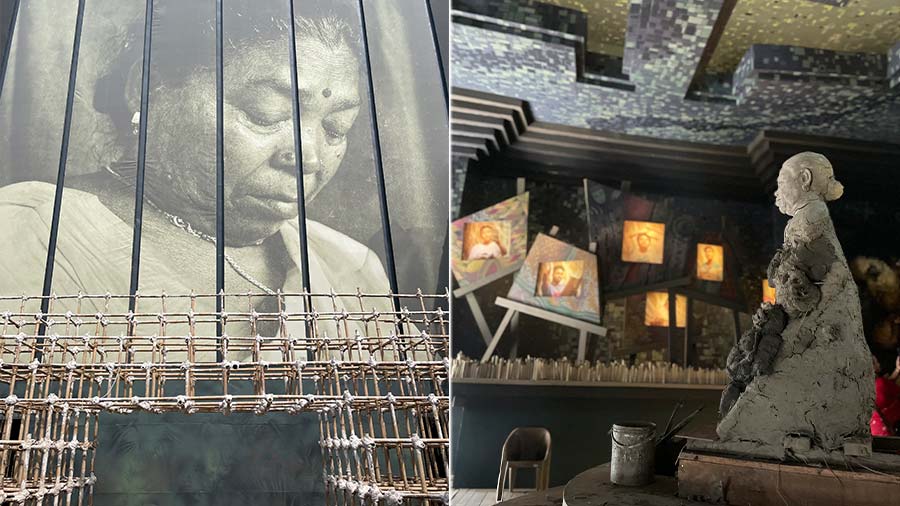
Jagat Mukherjee Park Puja focused on the life story of a woman who posed for Government Art College artists in the nude to earn a living
The second Pujo under this classification would be the one curated at Jagat Mukherjee Park — the life story of a woman who posed for Government Art College artists in the nude to earn a living. The Pujo committee put her face on display — 30 feet in height — complemented by a statue and a circular screen on which was projected her story, as described by the artists who worked with her (I initially wrote the word ‘recruited’ but felt it was inappropriate). I intend to request her number with the objective of making a small contribution as a debt of gratitude: she has helped enhance my aesthetic understanding at a personal cost. The least I can do is contribute and say thank you.
The art of making people laugh
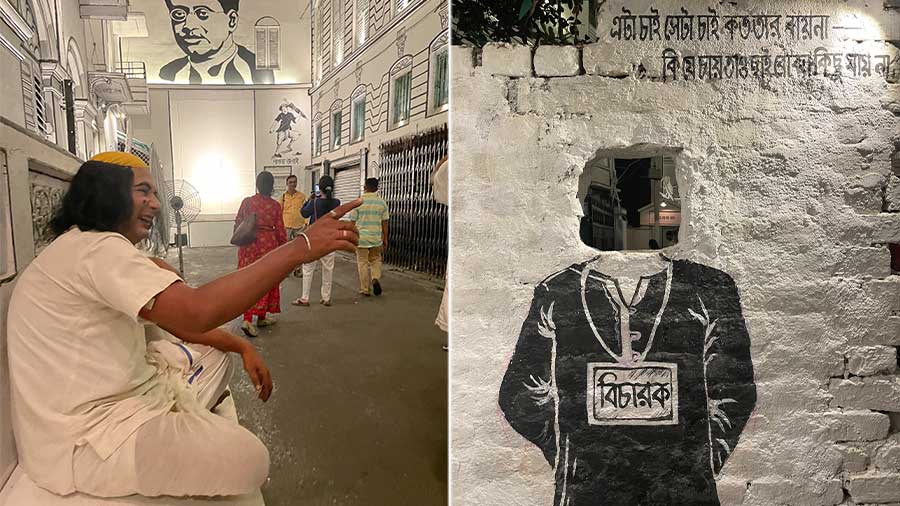
No installation ever has made visitors laugh as much as that by Hatibagan Nabin Pally’s treatment of 'Abol Tabol'
No Durga Pujo installation made people laugh this year except one; definitely no installation ever has made visitors laugh as much as that by Hatibagan Nabin Pally’s treatment of 'Abol Tabol'. The Pujo celebrated the nonsense writer (not to be confused with the content quality) and satirist Sukumar Ray (often recognised better for this son’s achievements). The Pujo could have curated murals and lines from the writer’s works; it transformed the passive into the active by having on-site actors perform brief skits and engage with the crowds. The unusual depictions of an unusual man: a hole in the wall (enough for head space) with the words ‘Bichaarak’ (Thinker) below; the name board of ‘Abol Tabol’ hung angled as if by deliberate intent and the protima resembling indents on metal plates ready to be printed upon; the names of streets in the neighbourhood for footfall guidance being consciously mis-spelt. This Pujo – in so many ways – captured what the Kolkatan is: a maverick cocking a snook at the world (‘aamra to ei rokom’). Maybe this installation needs to be re-erected for the 2024 Book Fair. Maybe it needs to become a permanent College Street exhibit. Maybe the neighbourhood could say ‘Eta shoraano jaabay na!’ and inspire footfall from across the state or country. I live on maybes.
The art of space management
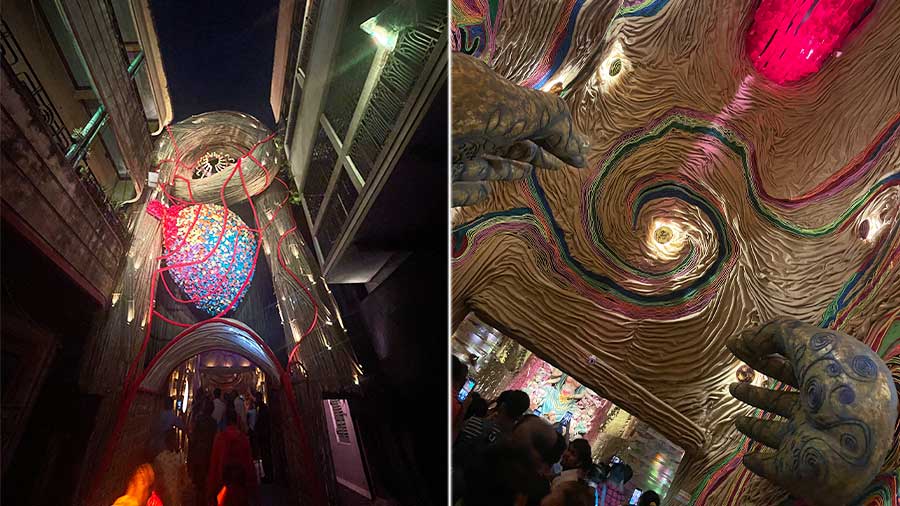
Nalin Sarkar Street Puja pandal
I took visitors from other cities to Nalin Sarkar Street in north Kolkata not so much to show them the face of the protima – which incidentally is one of the finest this year from among a field of hundreds – but to show them how artists, working in constrained physical environments, deliver. Nalin Sarkar Street is one of the narrowest lanes (possibly 12 feet in width); two vehicles from opposite ends can cause a constriction that spills into other bylanes; when the Durga Pujo installation begins, the lane becomes off-limits for two months. Within that strait jacket, this Pujo goes on to score consistently. After this Durga Pujo, I must call on the secretary to introduce me to neighbourhood residents so that I may ask just three words: ‘Oshubidha hoy na?’ The answers could become a treatise on the importance of placing public good over personal convenience, a relevant commentary in an increasingly self-centred world.
The art of making the visitor feel like a customer
I see more QR codes in Pujos, which indicates a larger willingness to tell installation stories. The one Pujo that took this willingness to the next level was Tala Prattoy. It did not just showcase this code for the thousands who visited and waited; it had its curator live on site for a fortnight (including sleep) so that he could communicate the concept. He must have said the same thing 140 times during the fortnight, averaging once every waking hour. This engagement represents the next level; it will not be enough for the curator to complete and vacate; the curator will have to be seen, questioned and heard for the installation to be appreciated. I cannot remember a single Pujo where the curator put himself/herself on public call or show; no Pujo had curator-clones to guide visitors; Naktala Udayan Sangha had a researched broadsheet placed inside the pandal to be picked for onward reading (discontinued after a few days).
The art of being subject-faithful
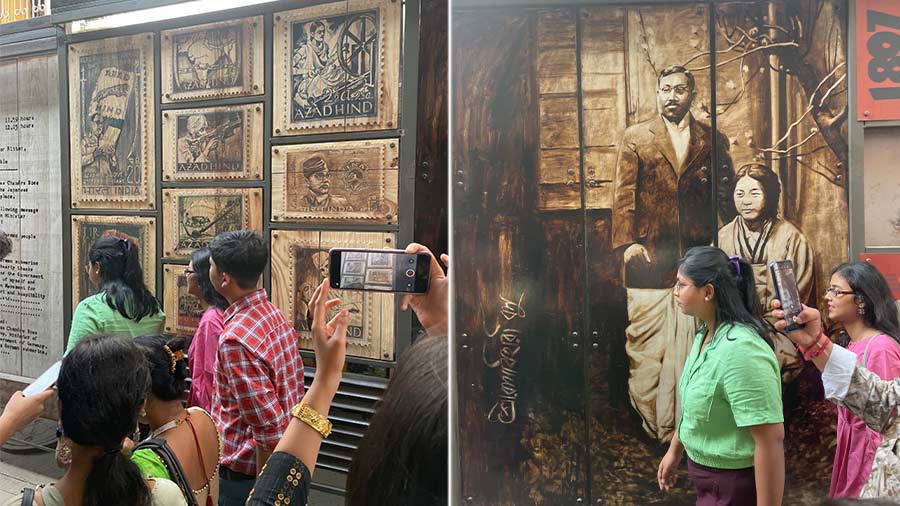
Dum Dum Park Tarun Dal's Pujo showcased extensive material on Netaji
Pujos will be increasingly appraised by lay visitors around ‘Faithfulness’. A new line of appraisal will emerge: ‘Pujo-ta bhaalo chhilo kintu aaro faithful hotei paarto.’ This is what I felt after visiting Dum Dum Park Tarun Dal’s treatment of the women who fought for India’s Independence. I expected to see dozens of women being celebrated; I could scarcely extract the name of one (Captain Laxmi Sehgal, who fought alongside Netaji in the Indian National Army). There was extensive material on Netaji (wonder why) but not a prominent word on Matangini Hazra, Bina Das or Preetilata Waddedar (fine print does not qualify). I saw an excellent painting of Rash Behari Bose on wood, which appeared irrelevant. This Pujo could have become a landmark but the research appeared shallow and scattered. Patted a half volley back respectfully to the bowler.

The rickshaw art at Mahim Halder Lane Puja
On the other hand, a smallish puja off Mahim Halder Lane in south Kolkata scored 8 out of 10 in my books on being kitsch — but comprehensively so — while addressing rickshaw art.
The art of making a visual impact
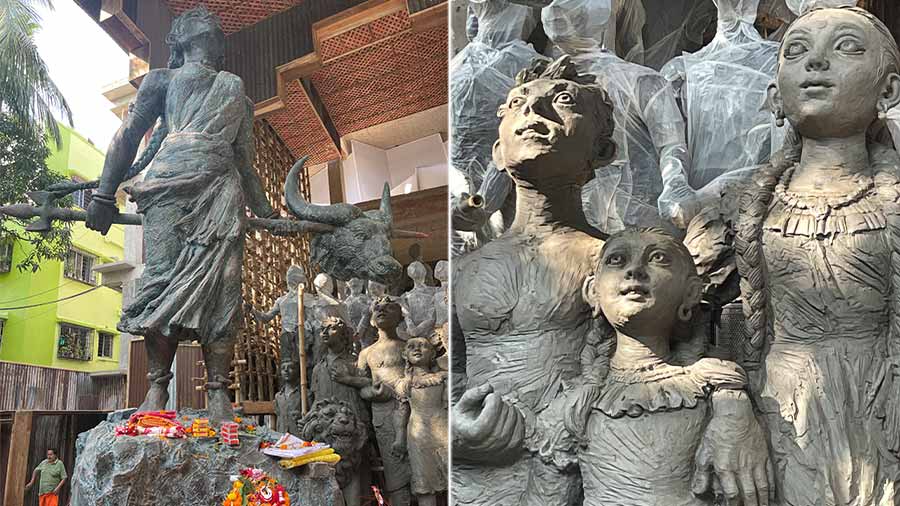
The Arjunpur Amra Sabai installation stood for courage in the face of adversity
There were a number of Pujos that made a remarkable visual impact. The body language of the protima at the Arjunpur Amra Sabai installation stood for courage in the face of adversity; this could be discerned even by uninformed eyes like mine through the chin-upness of the protima; the smaller idols, depicting the other gods and goddesses, stood for optimism and hope, a metaphor for humankind.
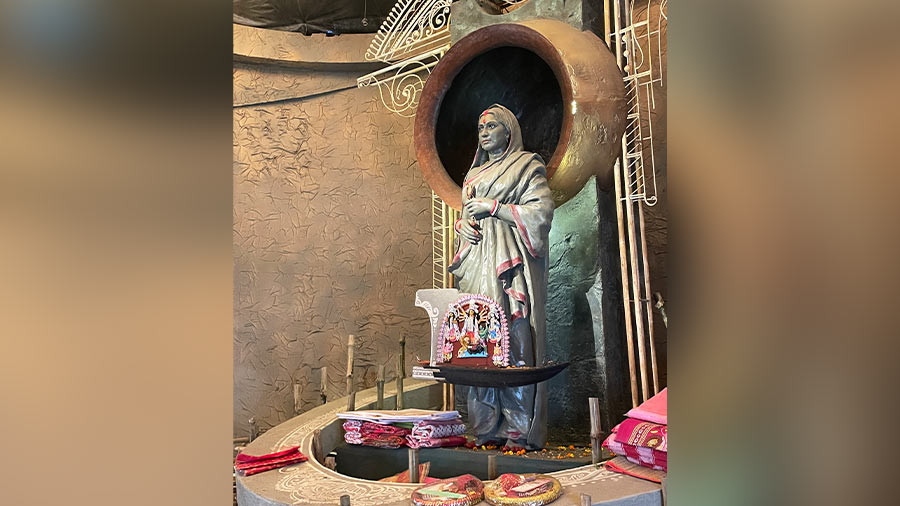
The dignified everyday-ness of the idol at Kalighat 64 Palli surprised us all
The ‘mamata’ reflected in the protima at 41 Pally (Haridevpur) was a stand-out; the dignified everyday-ness of the idol at Kalighat 64 Palli surprised; the under-stated serenity of the Shib Mandir protima remained the central attraction in an installation marked by understated-ness. I wish I had the courage to drive from Tollygunge to Sodepur to walk through the ‘Paris Opera’ or find parking space outside Rajdanga to see their magnificent Pujos, which appeared to be standouts based on the social media feed.
The art of engaging aurally
The Durga Pujo is largely being perceived as a visual engagement. During the last few years, a new dimension appears to be emerging. Sound. There are more Pujos that are investing in customised theme compositions that showcase the spirit of their installations. I can shortlist two with a stilling effect. Tala Prattoy employed the use of a solitary musical instrument in alaap mode; the sound was turned towards the higher volume, extending it beyond being just a sideplay; the chord vibration became the signature of the event. The Hindustan Road Pujo recorded a baul rendition of the need to plant more trees, which came off as fresh, raw and pure. The Naktala Udayan Sangha background score and song on a land one has left behind will be re-heard (and if the organisers have any juice left, could become a platform to take this theme to the next level). If I were to re-engage with the curator, I would ask for a recording of their background scores to be saved on my smartphone to graduate me to a different zone with the flick of a finger.
The art of evolving the local to the biennale
In the first stage of Kolkata’s Pujos that lasted until the mid-eighties, installations were conventional — to the point that it was difficult distinguishing one Pujo from the other because they looked virtually the same as they had looked across the previous 50 years. Then came the Asian Paints Sharad Samman Awards. Pujos now began to be curated around ‘How different?’ The third inflection point has possibly transpired in 2023 without most realising: the Tala Prattoy Pujo represents the next level of Pujo installations — the theme is over, the biennale is in. If TPP is to trend, Kolkata’s Pujos of the future will be multi-scale, multi-level, multi-dimensional (sound and shadow, etc.), multi-message and multi-experiential (including a dozen welcoming dhaakis leading select visitors from the gate to the installation, ‘making me feel like royalty’ as one of them said). The TPP also represents a new trend where, among other things, co-creators (the word ‘workers’ is passe) are celebrated on site through names and pictures (the only other installation where one saw this was Chorebagan, crediting the support staff by name, with one of the names being Pele). Naktala Udayan Sangha took the concept of credit a step further: it acknowledged artists whose design ideas influenced this Pujo with reference pictures.
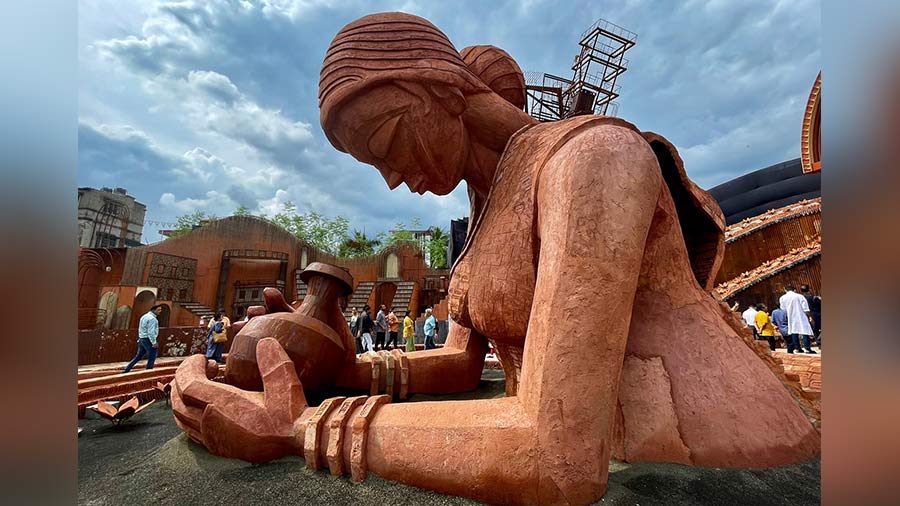
The Rajdanga Udayan Sangha Pujo
The other Pujo where I got a trace of a biennale effect — smaller scale — was the Rajdanga Udayan Sangha Pujo curated by Suvomoy-Moloy. The principal installation of a woman with her bowed head cast in brick represented the spirit of the city; the installation was positioned around the concrete forest of Kolkata that — despite the odds — retained her sensibility. Archana ‘Tuni’ Dutta from the organising committee highlighted the fine print: 200 artisans laboured, they were housed on site, the installation was started on Poila Baisakh, and 20,000 customised kiln-fired bricks were sourced. They are not yet biennale standard but they have the space, location and passion to keep raising their game. If this were a listed stock, I would have started accumulating with a whisper to my broker (‘Not a word on this to anyone’).
The art of engagement
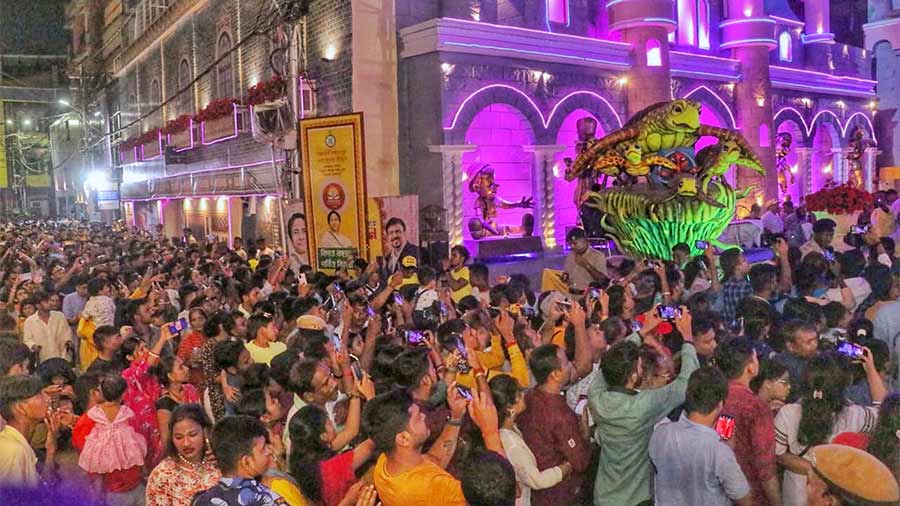
The Sreebhumis, Tridharas, Suruchi Sanghas and Santosh Mitra Squares were large but they appeared soul-less
The big Pujos continued to attract crowds — when I saw the crowd outside Suruchi Sangha on Tritiya at 11.15 pm, I called it a night and left. It is not the largeness of the crowd that intimidates (the one outside Santosh Mitra Square was at least a kilometre long and winding through the Jelepara bylanes, then onto Nirmal Chunder Street and then along BB Ganguly Street into Sealdah); it was ‘What does one do while one is waiting 60 minutes for a three minute ‘darshan’? These Pujos were large but they appeared soul-less. I didn’t come across anyone who said, ‘I want to go a second time to read another layer in the installation.’ They were built to awe, not endear. The more the Sreebhumis, Tridharas, Suruchi Sanghas and Santosh Mitra Squares understand that with enhanced budget comes a large responsibility, the more will the realisation emerge that being big may not necessarily mean being better.


